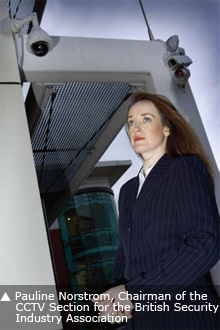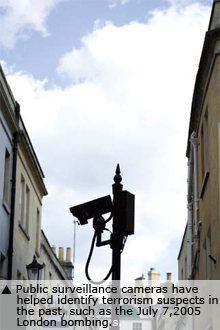Video cameras put eyes in more places, but are we really seeing more? The brazen
Dubai assassination suspects were captured on video but have largely eluded capture.
A&S examines whether public monitoring is effective.
Video cameras put eyes in more places, but are we really seeing more? The brazen
Dubai assassination suspects were captured on video but have largely eluded capture.
A&S examines whether public monitoring is effective.
Caught in the act. Busted. Captured red-handed. Catching the bad guys is clear-cut in the movies, with a witness making sure the perpetrator is brought to justice. However, there are not enough people to stand vigilant at all times. The security camera becomes a sentry, keeping watch and recording what it witnessed.
 More cameras are being deployed for evidentiary purposes. Specifically for terrorism, surveillance footage has helped nab suspects in the past. “Time and again the advantages of effective digital video evidence have been demonstrated through events such as the police investigation into 2005's London bombings,” said Pauline Norstrom, Chairman of the CCTV Section for the British Security Industry Association. “This massive intelligence exercise carried out by London's Metropolitan Police and surrounding forces was significantly aided by the presence of the surveillance systems covering the streets. Recordings from 28,000 cameras were cut down to seven hours of relevant footage to aid the investigation, and the pictures that were subsequently produced, such as those taken at Luton rail station of the 7/7 bombers on the irway to suicide missions, showed identifiable images of the perpetrators.”
More cameras are being deployed for evidentiary purposes. Specifically for terrorism, surveillance footage has helped nab suspects in the past. “Time and again the advantages of effective digital video evidence have been demonstrated through events such as the police investigation into 2005's London bombings,” said Pauline Norstrom, Chairman of the CCTV Section for the British Security Industry Association. “This massive intelligence exercise carried out by London's Metropolitan Police and surrounding forces was significantly aided by the presence of the surveillance systems covering the streets. Recordings from 28,000 cameras were cut down to seven hours of relevant footage to aid the investigation, and the pictures that were subsequently produced, such as those taken at Luton rail station of the 7/7 bombers on the irway to suicide missions, showed identifiable images of the perpetrators.”
However, seven hours of street footage requires quite a few eyeballs to watch it all. While the cameras placed the bombers at the scene of the crime, it took dogged police work to identify and capture them. A camera cannot be expected to solve everything, as it is just part of an investigation.
In the past year, surveillance came to the fore in January with the Dubai assassination. Local surveillance mandates yielded a near-perfect record of the hit on Hamas officer Mahmoud al-Mabhouh. The cameras faithfully recorded the perpetrators, who were remarkably bold.
“Team members walk through the airport, check in and out of hotels, get in and out of taxis,” said Bruce Schneier, security technologist and author, in a prepared statement. “They make no effort to hide themselves from the cameras, sometimes seeming to stare directly into them. They obviously don't care that they're being recorded, and — in fact — the cameras didn't prevent the assassination, nor as far as we know have they helped as yet in identifying the killers.”
While there is no way a camera can stop premeditated murder, it does seem odd that no one noticed the flurry of activity around Mabhouh's room. “Pervasive security cameras don't substantially reduce crime,” Schneier said.
Another high-profile event was May's failed bombing of Times Square, one of the most monitored places on earth. Faisal Shahzad set off a bomb in an SUV, which failed to ignite. He then simply walked away, while a street vendor noticed the smoking car and alerted the authorities. It took mere days to apprehend Shahzad, but not after operators reviewed footage from 80 cameras.
With all those cameras rolling but no one watching, it begs the question of whether public monitoring is effective. The answer comes down to why the cameras are there in the first place.
Practical Issues
A primary issue with cameras is whether they provide evidence-grade images. The British Standard BS8495 addresses exporting image data for evidence, so the footage carries weight in court, Norstrom said. This depends on image quality, authenticity and operator awareness, among other factors.
Another challenge in real life is integration. “Technology has limits,” said Chris Phinney, Senior Product Marketing Manager for Intrusion Systems, APAC, Bosch Security Systems. A city surveillance system will involve a camera capturing images, then software to analyze. Poor integration means the system will have limited performance.
 An urban cityscape is also challenging. “The technology and the integration aren't keeping up,” Phinney said. “The reason is there are so many factors that need to be taken into consideration, like environmental factors. Video analytics are not yet intelligent enough to adapt to all these different environmental factors.”
An urban cityscape is also challenging. “The technology and the integration aren't keeping up,” Phinney said. “The reason is there are so many factors that need to be taken into consideration, like environmental factors. Video analytics are not yet intelligent enough to adapt to all these different environmental factors.”
While Hollywood movies show street cameras performing facial recognition despite the villain's clever disguise, reality is harsher. An indoor environment, such as the customs area at an airport, can control factors such as lighting and position, Phinney said. An outdoor camera mounted on a lamp post will also record images, but may be affected by sunlight, branches or wildlife. Matching a photo of someone from a street location to a database has limits, due to insufficient image quality.
Limited budgets mean outdated cameras are recording, but the images are too low-quality for evidence. Cameras also break, reducing them to expensive decorations. Even if there are high-resolution cameras providing identifying detail, they may not stream images in real time.
Video surveillance is primarily for evidence, but it is difficult to sift through footage. “Looking at the expansion in the scale of video surveillance being deployed in our urban areas, as well as the increased integration of mobile and fixed solutions, there is certainly a pressing need for ways of managing the sheer volume of video footage,” Norstrom said. “This is where we are seeing a growing interest in database-driven solutions which can allow for the successful archiving and retrieval of digital video evidence being generated on a daily basis across multiple sites and systems.” This includes embedding metadata for more effective searches.
Best Practices
Cameras placed out in the open do affect behavior. Public surveillance cameras and signs that indicate an area is being monitored serve as noticeable deterrents. “You can then argue: Is it a deterrent or crime displacement?” Phinney said. “For example, the bad guy sees the camera and decides not to mug the lady, so he goes down the road to commit a crime where there are no cameras.”
Any camera installation should be carefully considered. “The organization looking at this has to weigh the advantages for its specific application,” Phinney said. “Measuring success is about achieving the objectives that the organization has.”
An installation's purpose must be clearly delineated before equipment is specified. “When it comes to video surveillance, however advanced it may be, there is little doubt that care needs to be taken in terms of how it is specified, installed, operated and maintained,” Norstrom said.
“As with any type of technology, the reality is that video surveillance never operates in a vacuum, so it is imperative that steps are taken to ensure that any solution is ‘fit for purpose' and that there is a real appreciation of the ‘bigger picture' context in which the surveillance infrastructure is to be applied,” Norstrom said. “Whether it be public-space monitoring or commercially operated surveillance, many of the principles which underscore best-practice surveillance are the same.”
 A holistic mindset is required for public monitoring. “Crime prevention through environmental design (CPTED) relies on whenever you design a system in a building to rely on natural surveillance,” Phinney said. “A characteristic of CPTED is open architecture, open viewing so everyone can see what's going on.”
A holistic mindset is required for public monitoring. “Crime prevention through environmental design (CPTED) relies on whenever you design a system in a building to rely on natural surveillance,” Phinney said. “A characteristic of CPTED is open architecture, open viewing so everyone can see what's going on.”
This approach emphasizes natural barriers that are aesthetically pleasing. “No one wants a city center that's like a military bunker,” Phinney said. “You need to be able to adopt certain aspects of CPTED.”
It is clear technology aids the capture of wanted criminals. However, real-life implementations mean the technology faces real-world limitations. “The storage, the signage, the lighting — all of these different aspects — are part of a system,” Phinney said. “You don't look at cameras and say they don't solve problems; you need to have a holistic view.”
In cases where there are concerns over the surveillance system's ROI, it is important to look at the context, Norstrom said. Examining whether the installation measures up to best practices — how it was specified, installed and maintained — is important before “rushing to any rash judgments as to the efficacy of surveillance at a wider context.”
Ultimately, it goes back to education. “The knee-jerk reaction is put up a camera after a mugging,” Phinney said. “Next week, someone else is mugged, so the reaction is that the camera is no good. That camera needs proper lighting, a sign and a system that if you see something, you call this number. It's a different story when you also adopt the other measures to be much more effective.”
Surveillance cameras are still necessary, but only as part of the equation. A response plan must be drawn up to take action. “To ensure that any public-space surveillance infrastructure is effectively deployed and maintained, members of the general public should be encouraged to be ever-vigilant and to report their concerns to the police,” Norstrom said.
Surveillance does catch the bad guys, when deployed correctly. The evidence captured by cameras helped put away the London bombers, along with the perpetrators of the unsuccessful attempt two weeks later, Norstrom said.
However, effective monitoring requires forethought about what the cameras are meant to do. This extends into the response network, with a clear plan about what action to take.
Cameras will never find Osama bin Laden in a packed football stadium, but they can offer valuable assistance to the authorities.